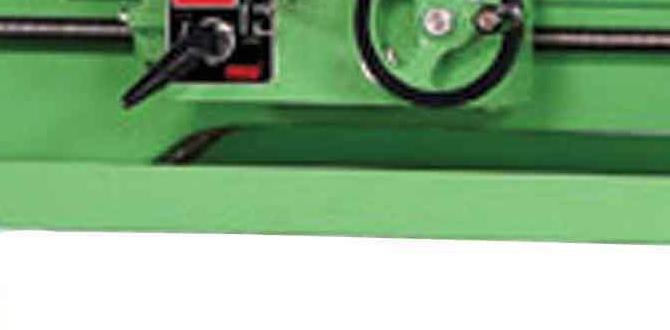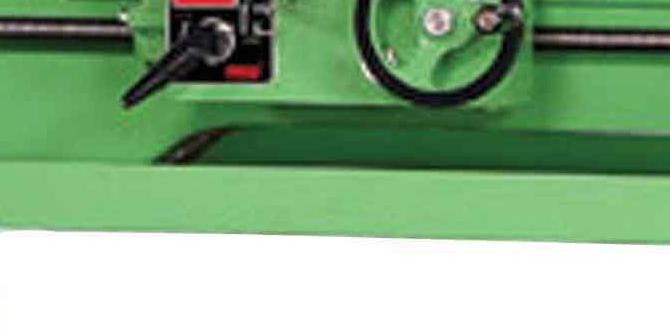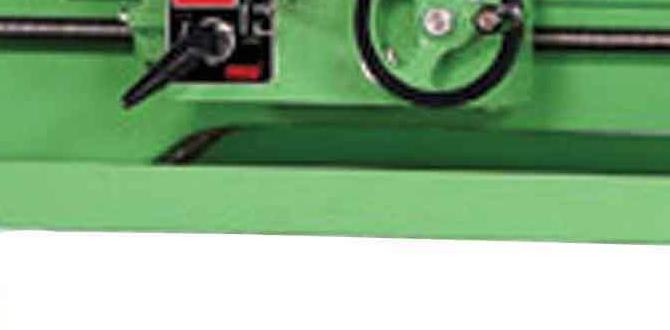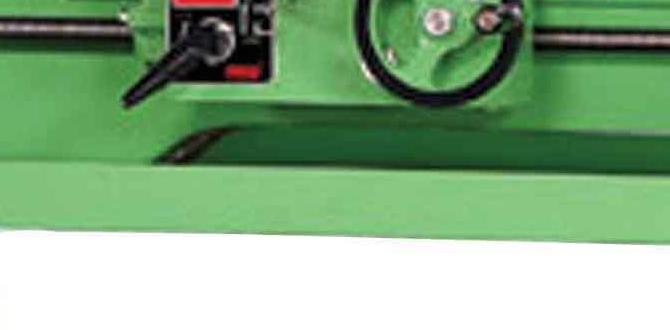Quick Summary: Build a DIY wood lathe tool sharpening machine to keep your turning tools razor-sharp, ensuring cleaner cuts and a smoother woodworking experience. This guide provides easy-to-follow steps so even beginners can create an effective sharpening setup at home.
Welcome to Lathe Hub! As any woodturner knows, a dull tool is more than just frustrating – it can be dangerous and leads to subpar results. Instead of constantly buying new chisels or spending a fortune on professional sharpening services, why not build your own wood lathe tool sharpening machine? It’s a rewarding DIY project that will serve you well for years. We’ll guide you, step-by-step, on how to create a reliable and effective sharpening setup right in your workshop. Get ready to transform your turning experience and breathe new life into your favorite tools!
Why a DIY Wood Lathe Tool Sharpening Machine is a Game-Changer
A sharp chisel is the heart of successful woodturning. When your tools are dull, they don’t cut; they tear. This means more effort for you, a rougher finish on your workpiece, and a higher risk of catches and accidents. While professional sharpening services exist, they can be costly and time-consuming. Even store-bought sharpeners might not offer the precision or versatility you need for all your specialized woodturning tools.
Building your own wood lathe tool sharpening machine DIY is an excellent solution. It allows you to:
- Maintain a consistent, razor-sharp edge on all your turning tools.
- Save money in the long run.
- Customize your sharpening setup precisely to your needs and workspace.
- Gain a deeper understanding of your tools and how to care for them.
- Reduce the risk of dangerous tool failure due to dullness.
This guide is designed for beginners, breaking down the process into manageable steps. We’ll focus on a common and effective design that uses readily available materials and basic tools, making it an achievable project for most home workshop enthusiasts. Let’s get started on building a tool that will elevate your turning performance.
Understanding the Basics of Tool Sharpening
Before we dive into building, let’s quickly cover what makes a tool sharp. For woodturning tools, sharpening isn’t just about getting an edge; it’s about establishing the correct bevel angle and creating a flawless, burr-free cutting edge. The bevel is the angled surface that meets the wood, and its angle determines how the tool cuts.
Common bevel angles for woodturning tools:
- Gouges (Bowl and Spindle): Typically 35-45 degrees (often with a swept-back wing for gouges).
- Scrapers: Sharpened with a small burr, not a traditional bevel.
- Skew Chisels: Have a specific geometric shape with a subtle bevel.
- Parting Tools: Require a very narrow, precise bevel.
A sharpening machine helps you achieve and maintain these precise angles consistently. It typically involves an abrasive surface (like a grinding wheel or belt) that you bring your tool’s bevel against. The key is controlled, repeatable contact.
Choosing Your DIY Sharpening Machine Design
There are a few popular DIY approaches to wood lathe sharpening machines. The most common and beginner-friendly designs often revolve around:
- Grinding Wheel Setup: Uses a standard bench grinder with specialized jigs.
- Belt Sander Setup: Utilizes a belt grinder or repurposed belt sander with jigs.
- Disk Sander Setup: Employs a disk sander with precisely angled jigs.
For this guide, we’ll focus on a versatile design that can be adapted for either a bench grinder or a belt sander, as these are often readily available to woodworkers and machinists. This design emphasizes building a sturdy, adjustable jig that ensures consistent bevel angles.
Essential Materials for Your DIY Sharpening Machine
Gathering your materials is the first concrete step. Aim for sturdy components that will withstand vibration and heat. For a robust and adaptable jig, you’ll want:
For the Main Jig Structure:
- Wood: Sturdy hardwoods like oak, maple, or even Baltic birch plywood (3/4” or 1” thick) are excellent choices for the base and support parts.
- Metal: Aluminum or steel angle iron (1”x1” or similar) for reinforcing edges and creating mounting points.
- Fasteners: Wood screws, machine screws, nuts, and washers.
- Hardware: Drawer slides (heavy-duty), T-track, or a simple sliding mechanism with wooden runners.
Essential Components for the Grinding/Sanding Area:
- Abrasives:
- For bench grinders: Diamond grinding wheels (excellent for metal and long-lasting but pricier) or standard aluminum oxide grinding wheels. Consider a fine-grit wheel (e.g., 60-80 grit) for initial shaping and a finer stone (e.g., 120-220 grit) for refinement.
- For belt sanders: Sanding belts in various grits (60, 120, 220, 400).
- Motor: Either the motor from a standard bench grinder or a dedicated motor (1/2 HP or greater) if building a standalone belt grinder.
- Shaft/Arbor: To mount the grinding wheel or pulley system.
- Pulleys and Belt: If building a belt grinder from scratch.
Optional but Recommended:
- Water Trough/Coolant System: To keep tools cool and prevent overheating, especially with grinding wheels. Even a simple shallow tray can help immensely.
- Dust Collection Port: If using a belt sander or grinder that produces significant dust.
- Magnifying Lamp: For inspecting the edge.
- Angle Gauge: To precisely set bevel angles.
Pro Tip: When selecting your abrasive, remember that coarser grits remove material faster but can leave a rougher finish. Finer grits refine the edge but take longer. A two-stage system (one coarser, one finer) is ideal.
Tools You’ll Need for Construction
Your existing workshop tools will likely suffice. Here’s a list of common tools:
- Measuring Tools: Tape measure, ruler, combination square.
- Cutting Tools: Hand saw, circular saw, or table saw for wood; hacksaw or metal-cutting saw for metal parts.
- Drilling Tools: Drill press (highly recommended for accuracy) or a hand drill with various drill bit sizes.
- Fastening Tools: Screwdriver set, wrench set, clamps.
- Safety Gear: Safety glasses (essential!), hearing protection, dust mask.
If you’re new to metalworking, consider a drill press for drilling metal parts. It provides more control and accuracy than a hand drill.
Building Your Wood Lathe Tool Sharpening Machine: Step-by-Step
This guide outlines a common jig design that attaches to a bench grinder. It’s adaptable for belt sanders with minor modifications.
Step 1: Design and Cut Your Base
You need a stable base that won’t vibrate excessively. Cut two pieces of hardwood or thick plywood to form an elevated base. A common design is an “X” shape or a rectangular base with two support arms.
Example Dimensions:
- Two base pieces: 10” x 4”
- Two support arms: 12” x 4”
These pieces will form a stable platform to mount your sliding mechanism.
Step 2: Create the Sliding Mechanism
This is where your tool will rest and slide against the abrasive. You need a way to guide the tool smoothly and set precise angles.
Option A: Drawer Slides
- Mount one part of a heavy-duty pair of drawer slides to the base.
- Mount the other part of the slides to a wooden platform or carriage. This carriage will be where you attach your tool rest.
- Ensure the slides move smoothly and have minimal wobble.
Option B: Wooden Runners
- Cut two matching wooden runners (e.g., 1” x 1” strips).
- Create a matching groove in your base platform and the sliding carriage.
- Lubricate the runners with wax or a silicone spray for smooth movement.
Option C: T-Track System
- Install T-tracks onto your base and across a sliding carriage.
- Use T-bolts and knobs to secure the carriage, allowing it to slide and then be locked in place.
For a beginner-friendly build, drawer slides or wooden runners are often the easiest. The key is a smooth, repeatable motion.
Diagram of Sliding Mechanism Concept:
| Component | Description | Function |
|---|---|---|
| Base Platform | Fixed to your bench or grinder stand. | Provides a stable foundation. |
| Drawer Slides (or Wooden Runners) | Two pairs, one set attached to base, one to carriage. | Guide the carriage’s movement back and forth. |
| Sliding Carriage | A wooden block or platform. | Rests on the slides and holds the tool rest. Moves towards the abrasive. |
| Tool Rest | A plate or angled surface mounted on the carriage. | Where the bevel of the tool is placed for sharpening. |
Step 3: Construct the Tool Rest and Angle Adjustment
The tool rest is critical. It needs to be adjustable, or at least set to an angle that matches your desired bevels. You can create a fixed angle rest or an adjustable one.
Fixed Angle Tool Rest:
Cut a piece of hardwood at your most common sharpening angle (e.g., 40 degrees for gouges). Mount this securely to the sliding carriage. Most often, this rest will be angled outwards so that when the carriage is pushed forward, the tool’s bevel naturally contacts the grinding wheel at the correct angle.
Adjustable Tool Rest:
Mount a pivoting plate to the carriage. Use a bolt and wingnut as a pivot point. You can then slot holes or use a cam lever system to set the angle precisely and lock it. This is more complex but offers greater flexibility.
Attaching to Grinder:
Your entire jig (base and sliding mechanism) will likely need to be mounted to the bed of your bench grinder or a sturdy plate behind the grinding wheel. Measure carefully where the grinding wheel will contact the tool rest.
Step 4: Mount Your Abrasive Source
This is where the sharpening happens. You’ll need to securely mount your grinding wheel or belt sander.
For Bench Grinders:
- Ensure your bench grinder is securely mounted to a workbench.
- If your grinder has a tool rest, remove it.
- Position your DIY jig so the tool rest face is at the correct distance and angle to the grinding wheel. You might need to build a small mounting plate or use clamps to fix the jig’s base to the grinder’s frame or bench.
- Safety First: Ensure the grinding wheel is perfectly centered and balanced. Never use damaged wheels. Always use the wheel guard.
For Belt Sanders:
- If using a dedicated belt grinder, you’ll have a platen (flat surface) against which the belt runs. Your jig will be positioned in front of this.
- If adapting a benchtop belt sander, you might set up your jig to present the tool to the belt as it runs over a rest or wheel.
External Link: For safe operation and maintenance of grinding wheels, consult the OSHA Grinding Facts document. This provides crucial safety information for anyone using grinding equipment.
Step 5: Testing and Calibration
Before sharpening any valuable tools, test your setup. Use an old, inexpensive chisel.
- Angle Check: Place the chisel on the tool rest, ensuring the bevel contacts the wheel. Use an angle gauge to verify the angle of contact. Adjust your jig as needed.
- Smoothness: Push the sliding carriage back and forth. It should move freely without binding but also without excessive play.
- Contact Pressure: Apply light, consistent pressure. Let the wheel do the work.
- Heat Management: Sharpen in short bursts. Dip the tool in water frequently to prevent overheating the steel, which can ruin its temper.
Consider an Angle Gauge: A simple digital angle gauge or even a protractor can help you dial in your tool rest angle precisely.
Table: Common Bevel Angles Guide
| Tool Type | Typical Bevel Angle | Notes |
|---|---|---|
| Spindle Gouge | 30-40 degrees | For detailed work and spindle turning. |
| Bowl Gouge | 35-45 degrees | More robust for hollowing and finishing bowls. |
| Skew Chisel (Detailer’s) | 40-50 degrees | For fine detailing and shearing cuts. |
| Skew Chisel (Roughing/Finishing) | 20-30 degrees | For shaping rough stock or smooth shearing cuts. |
| Scraper (Round/Dove Tail) | No traditional bevel | Sharpened to create a small burr. |
| Parting Tool | 75-85 degrees | Very narrow bevel for precise parting. |
| Nose Scraper | 30-45 degrees | For smoothing internal curves in bowls. |
Sharpening Specific Woodturning Tools with Your Machine
Once your machine is built and calibrated, you can tackle different tools. The motion is generally the same: present the tool’s bevel to the abrasive and push it forward to sharpen.
Sharpening Gouges (Bowl and Spindle)
- Set your tool rest to the desired angle (e.g., 40 degrees).
- Hold the gouge with the flute pointing upwards.
- Place the bevel of the cutting edge against the grinding wheel or belt.
- Push the carriage forward while slowly rotating the gouge to maintain edge contact.
- Sharpen for a few seconds, then plunge the tool into water to cool.
- Repeat until a fine burr forms.
- You can use the side of the gouge (“wings”) to touch the wheel for a moment to refine the edges.
Tip: For bowl gouges, aim for a fingernail grind (a rounded profile). For spindle gouges, a more pointed profile is common.
Sharpening Skew Chisels
Skew chisels are trickier due to their shape. The goal is to sharpen the entire bevel edge.
- Set your tool rest to the correct angle for your skew (often 20-30 degrees for roughing, slightly more for fine work).
- Place the skew bevel against the wheel.
- Push the carriage forward, keeping the cutting edge perfectly aligned with the wheel’s rotation.
- You’ll need to slightly pivot the skew as you push it forward to sharpen the entire edge from tip to heel (or nose to tail).
- Work in very short bursts and cool the tool frequently.
External Link: Learn more about the geometry of skew chisels and how to sharpen them from reputable woodworking resources. (Woodworkers Journal provides excellent tutorials on tool techniques.)
Sharpening Scrapers
Scrapers aren’t sharpened to a “sharp” edge in the traditional sense






